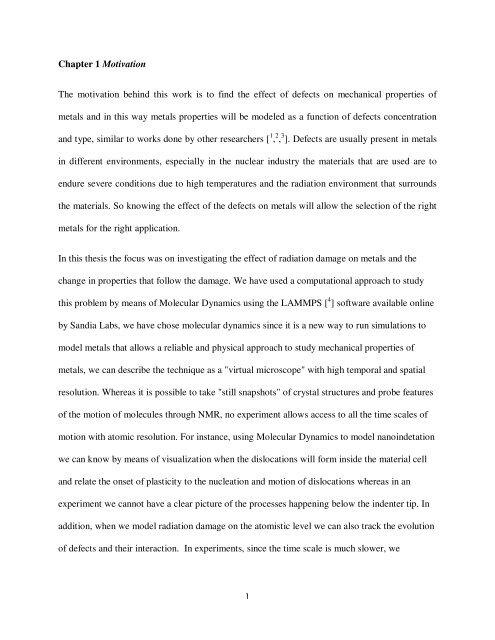DEFECTS IN METALS AND SIMULATION OF MECHANICAL ...
DEFECTS IN METALS AND SIMULATION OF MECHANICAL ...
DEFECTS IN METALS AND SIMULATION OF MECHANICAL ...
Create successful ePaper yourself
Turn your PDF publications into a flip-book with our unique Google optimized e-Paper software.
Chapter 1 Motivation<br />
The motivation behind this work is to find the effect of defects on mechanical properties of<br />
metals and in this way metals properties will be modeled as a function of defects concentration<br />
and type, similar to works done by other researchers [ 1 , 2 , 3 ]. Defects are usually present in metals<br />
in different environments, especially in the nuclear industry the materials that are used are to<br />
endure severe conditions due to high temperatures and the radiation environment that surrounds<br />
the materials. So knowing the effect of the defects on metals will allow the selection of the right<br />
metals for the right application.<br />
In this thesis the focus was on investigating the effect of radiation damage on metals and the<br />
change in properties that follow the damage. We have used a computational approach to study<br />
this problem by means of Molecular Dynamics using the LAMMPS [ 4 ] software available online<br />
by Sandia Labs, we have chose molecular dynamics since it is a new way to run simulations to<br />
model metals that allows a reliable and physical approach to study mechanical properties of<br />
metals, we can describe the technique as a "virtual microscope" with high temporal and spatial<br />
resolution. Whereas it is possible to take "still snapshots" of crystal structures and probe features<br />
of the motion of molecules through NMR, no experiment allows access to all the time scales of<br />
motion with atomic resolution. For instance, using Molecular Dynamics to model nanoindetation<br />
we can know by means of visualization when the dislocations will form inside the material cell<br />
and relate the onset of plasticity to the nucleation and motion of dislocations whereas in an<br />
experiment we cannot have a clear picture of the processes happening below the indenter tip. In<br />
addition, when we model radiation damage on the atomistic level we can also track the evolution<br />
of defects and their interaction. In experiments, since the time scale is much slower, we<br />
1

















